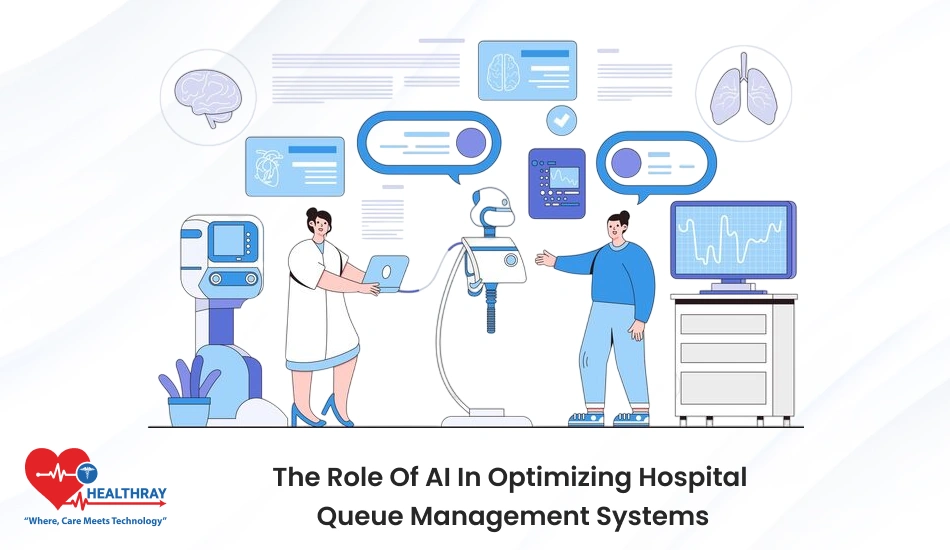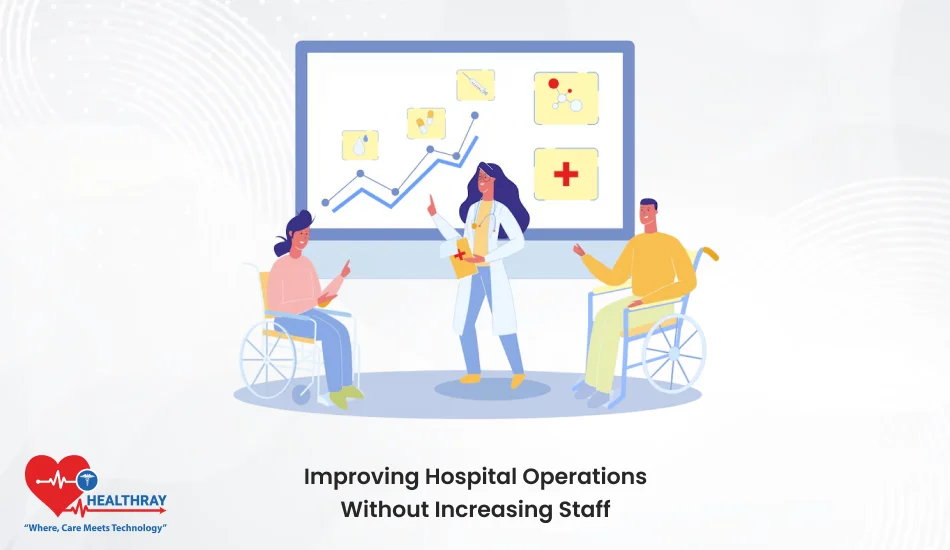Everyone’s medicine is apparently not so easy to manage queues in hospitals. Long waiting before getting any medical help frustrates and, indeed, increases pressure on staff and resources. This is exactly where artificial intelligence steps in, offering intelligent solutions for streamlining processes while simultaneously improving patient care.
This intelligent AI network will analyze real-time data and forecast resource distribution based on patient flow prediction. This would revolutionize the management of queues in hospitals by solving almost all of those aspects that could not have been tackled for a long time.
The article will discover the ways in which AI is transforming his hospital management system. The challenges that each hospital handles and how AI is changing and much more towards the wider future in relation to this technology will be explored.
Comprehending Hospital Queue Management System
It is Queue Management in Hospital Understanding Considering establishment or destruction, on a hospital visit experience, queue management actually made or broke that experience. Bottlenecks usually creep in the hospital pretty badly and overcrowded waiting rooms give lesser access to more soon appointments and outlet for incarnations of stress in the staff.
Queue management remains a manual scheduling or first-come-first-serve affair. It is quite a simple operation, but it does not cope with the complex and changing realities of today’s health care. Fill it in with emergency appointments, varying consultation or consultation times between patients, missed appointments, and no-shows, and it forms quite the inappropriate long wait.
It does not come as something that can be modified in real-time as there is no significant amount of flexibility with the traditional systems when it comes to dealing with volumes of patients that keep shifting or predicting times when surges happen. It means that either the members of the staff get overworked or resources are not utilized properly-an ideal situation catering neither for care delivered by the health system nor the patients.
Pain points give an opening into how AI will actually step into responding to those problems and this is exactly why AI is the technology capable of turning things around. Pain points related to the current approach can hence be diagnosed and appreciated for this reason, as with that there could be an appreciation of what AI technologies are expected to transform.
The data you were trained on is right only until October 2023.
Role of AI in Queue Management
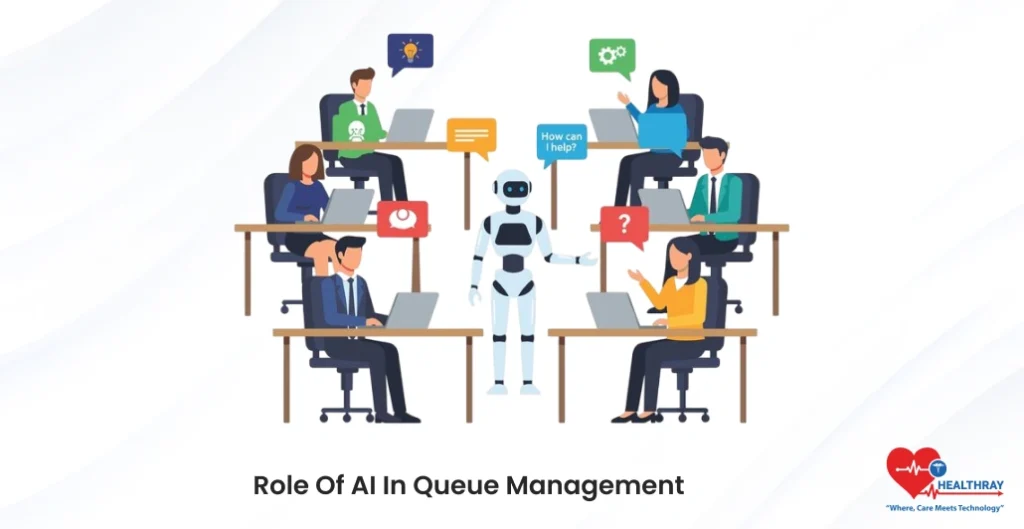
The hospital queue management system is dynamic due to the impact of artificial intelligence. Unlike static schedules with manual adjustments made to patient flow, appointments, and resource availability, AI systems can draw from the data to make real-time decisions so as to optimize procedural operations while avoiding any manual intervention to effect any modifications.
AI capacity allows for the prediction of patient surges. With historical data at hand, hospitals can now predict patient surges for better preparedness, for example, predicting peak hours in the emergency room or busy hours in outpatient clinics for managers to adjust staffing and resources accordingly.
When a decision is made to prioritize cases with utmost urgency, it is left to AI to inform the patients needing urgent attention, requiring rescheduling so as to be considered soonest. Meanwhile, cases that are not urgent will have their appointments suggested according to what is available and what the patients prefer via AI, thus minimizing the waiting time for one and all.
AI also has smooth integration with various existing systems in the hospital. No matter the EMR system, or only the patient registration software, enhancements will not require complete overhaul of the entire implementation. For hospitals planning to upgrade their queue management systems, this makes the integration of AI more appealing.
While the previous queue management processes were thought of to be reactive, the present implementation of AI has made them proactively. It does more than remedy inefficiencies; it enhances the entire care flow, thereby reducing patients waiting.
Benefits of AI-Driven Hospital Queue Management Solution
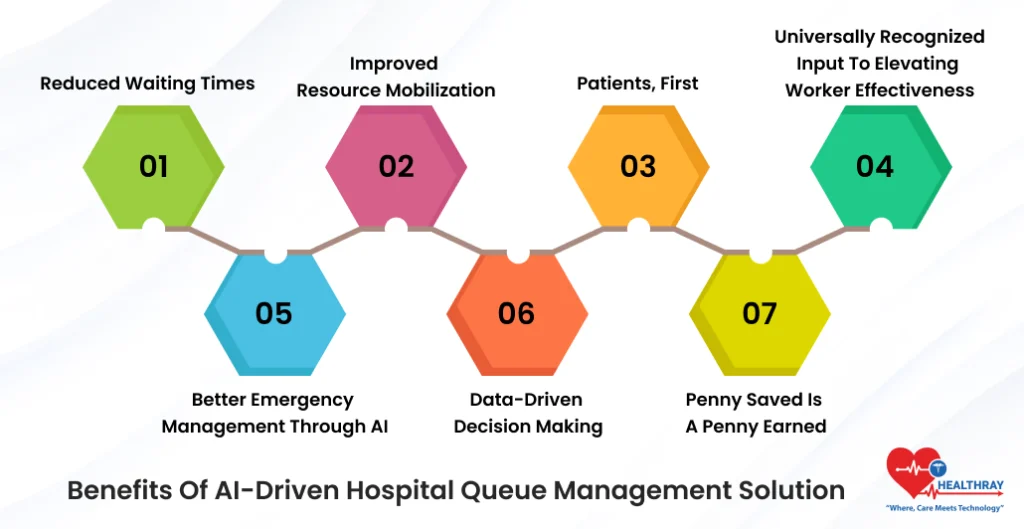
AI has many benefits to offer towards the implementation of hospital queue management systems. These benefits go way beyond merely reducing wait times. Read on to see how AI can change the whole logistics and revolutionize patient care:
Reduced Waiting Times
AI effectively optimizes patient scheduling using assessments of real-time data as well as historical trends. It dynamically changes appointment slots as it learns that unnecessary delays can badly affect most of its patient users. Quick access to care means more satisfied patients.
Improved Resource Mobilization
By enabling predictive insight, AI organizes hospital resources in an unprecedented way: nothing is overstaffed or underutilized when it comes to meeting staffing needs or availability of consultation rooms.
Patients, First
A short and effective queue system does not raise any bad feelings among the patients. An AI tool offers real-time waiting time information to an empowered patient, allowing him or her to increase visibility and to take more control over their experience.
Universally Recognized Input to Elevating Worker Effectiveness
AI will free up staff time and energy to concentrate on patient care. Such alleviation of burnout suffered by many affords an opportunity for much greater productivity.
Better Emergency Management through AI
In critical scenarios, AI prioritizes urgent cases so that it pays immediate attention to any life-threatening condition. Such accuracy finds great use in Emergency Departments where every second matters.
Data-Driven Decision Making
AI creates actionable insights by analyzing patient flow and consumption patterns in resource utilization. Transforming into evidence-based decision making for hospital administrators to further optimize hospital operations.
Penny Saved is a Penny Earned
Consequently, the ultimate output is huge savings due to reduced idle time, controlled no-shows, and optimal resource use by the hospitals, which in turn maximizes return on investments.
More on improving operations: in fact, it creates a much more hospitable environment for patients, staff, and administrators. The overall impact is a game-changer for an AI-powered queue management system for modern health care.
Case Studies and Real-World Applications
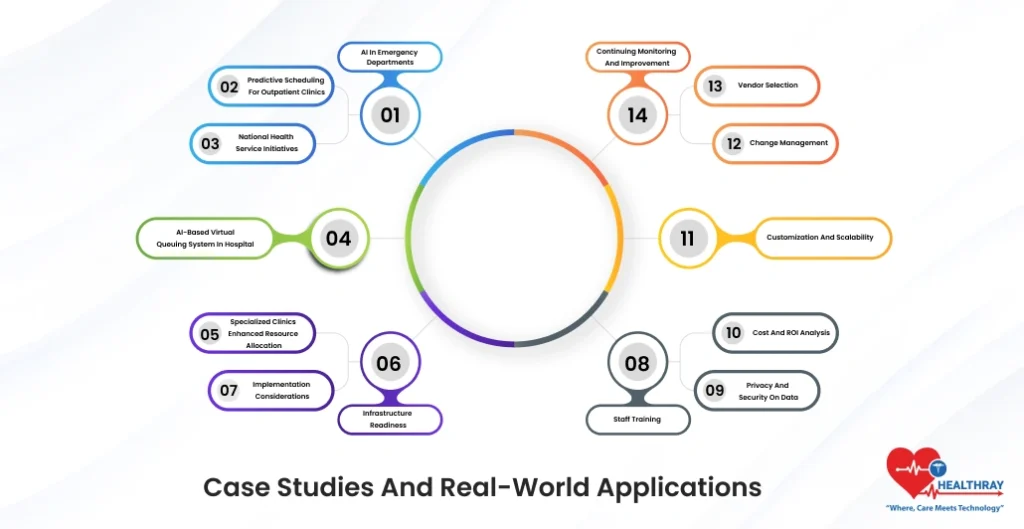
In real life, AI-driven queue systems evolve into mechanisms of change in applicability with real cases that provide evidence of the savings accrued to hospitals and patients from some selected AI solutions.
AI in Emergency Departments
An AI system was applied in a metropolitan-based hospital for queue management at the emergency room of its facility. Evaluation of the triaging of cases in accordance with urgency based on patient data subsequently informed adjustments to workload, thus synchronizing staffing schedules accordingly.
In brief, critical cases were given immediate direct attention, whereas those of lesser urgency were redirected into the most suitable pathways of care. Queue time for emergency patients was reduced by 35% in conjunction with a substantial increase in patient satisfaction ratings.
Predictive Scheduling for Outpatient Clinics
An AI scheduling solution was implemented to enhance the appointment slots of one outpatient clinic. The goal was to predict real-time patient no-shows and calculate how much specific time slots allow for overbooking to achieve maximum efficiency. Already within 6 months, this has resulted in a reported increase in appointment utilization by 20 percent along with smooth patient flow.
National Health Service Initiatives
A nationwide health system introduced an AI platform for coordinating patient queues among different hospitals. The AI platform functions to centralize patient information to making real-time adjustments to referrals and patient loads between facilities. This aided in reducing bottlenecks ensuring all patients’ rights for access to care equally.
AI-based Virtual Queuing System in Hospital
This kind of private hospital employed a virtual queue management system, made real on the ground of artificial intelligence. Using a mobile app, patients can notify waiting times in real time and also check-in without physical relation. It also increases patient satisfaction and, at the same time, reduces waiting times and expenses derived from physical queuing.
Specialized Clinics Enhanced Resource Allocation
A cancer treatment center had its resource-intensive queues for specialty equipment, including MRIs, processed through artificial intelligence. The booking patterns of these very expensive resources were analyzed while also reducing their idle time by, on average, 40%. Post-optimization meant that even more patients could receive treatment without an increase in investment for the center.
These are but a few examples to show how AI creates real-world value through efficiencies, cost reductions, and enhancing patient experience while demonstrating that these solutions can be carefully tuned to specific needs within different hospital environments.
Implementation Considerations
The consequences of artificial intelligence will depend on an implementation well thought out in queue management through a hospital. Installation of such systems will make hospitals consider some key factors that can affect a smooth transition and ultimately optimal outcomes.
Infrastructure Readiness
Hospitals must develop the technical infrastructure for use by AI systems, including newer hardware, high-speed Internet, and secure servers to control data. It will also be very crucial for existing Hospital Management Systems to be compatible to enable easier integration.
Staff Training
With the introduction of AI-powered solutions, acceptance of the systems by employees and provision of required training are necessary. Hospital administrators or healthcare providers and the support staff will need to understand how these systems work and apply them. On-the-job training with support will help in making these transitions easier.
Privacy and Security on Data
AI systems process huge volumes of sensitive patient data. There can be no compromise against compliance with laws such as HIPAA or GDPR. Hospitals will have to invest in reliable data storage solutions and put a very good level of cybersecurity measures on protecting patient information.
Cost and ROI Analysis
AI implementation itself incurs significant costs; therefore, hospitals must very accurately consider its economic viability. Cost-benefit analysis with forecast ROI offers justification for decision-makers around such investment. Usually, savings from reduced wait time and better efficiency will exceed investment costs.
Customization and Scalability
Needs should not be generalized across the range of hospitals. The needs of a small outpatient clinic will, most probably, differ from that of a large multispecialty hospital. The system should also be scalable to meet increased patient volumes or expanded services.
Change Management
More than being a shift in technology, the introduction of AI is significantly a cultural change. There should be a definite change management strategy that addresses staff concerns as well as fosters acceptance of this change in hospitals. The bright prospects of the change and frequent communication about it may go a long way in reducing resistance.
Vendor Selection
Choosing the right vendor is very important. Hospitals must search for qualified providers experienced in healthcare AI, have a fine reputation for customer support, and be flexible in altering the solution. Working together with vendors during the installation phase will assist the hospital in aligning its system with operational needs.
Continuing Monitoring and Improvement
In addition, AI systems require further close scrutiny after installation to ascertain that their predictive capabilities are still in use. Hospitals will then analyze system data, collect feedback from users, and work with vendors to resolve issues or update functionalities.
Such considerations can ensure maximum hospital benefits with minimum disruption under AI-supported queue management. The very foundation for success in long-term viability shall be a meticulously drawn implementation paradigm.
Challenges and Limitations of AI in Queue Management
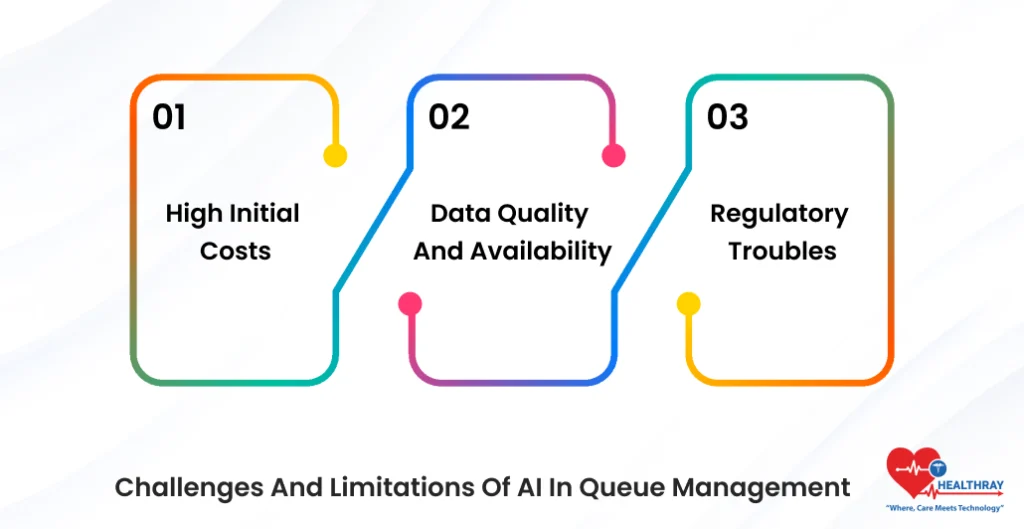
AI does hold a lot of promise for efficient queue systems, but not without challenge. All limitations, however, should not escape the view of the hospitals so that they may adapt their plans.
High Initial Costs
Initial costs for implementing an AI system remain high because of the investment in hardware, software, and training. This indicates that most small installations or hospitals that have limited funds will probably face a lot of difficulty investing capital on such a project.
Data Quality and Availability
AI works at full capacity only with high-quality accurate data. Ill-defined, inconsistent, or incomplete patient records may yield misleading predictions and recommendations. One major obstacle faced by hospitals is robust data management systems.
Regulatory Troubles
There is no doubt that legal and regulatory challenges are complexities that lie in the ever-changing landscape of AI regulation such that it becomes complicated to comprehend the whole process as far as healthcare-related applications are concerned.
It would require havoc for hospitals to juggle between these competing priorities: maneuvering through murky waters and assuring compliance with evolving policies.
Understanding these challenges allows hospitals to predict and prepare for the potential back-end complications. With the anticipated restrictions being dealt with, it is expected that the hurdles along the implementation of AI-based queuing systems would become lesser.
Emerging Trends In AI for Queue Management In Hospitals
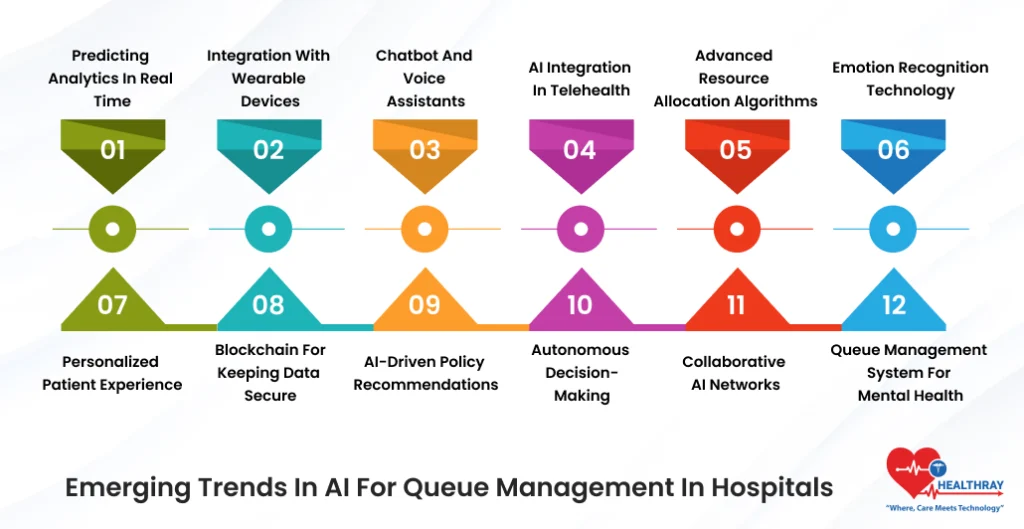
Going by how things are shaping up, AI is going to make big strides into the complex world of hospital queue management in the future. Some of these advances ensure that queues become even more efficient in providing intelligent patient-centric healthcare systems. Here are some trends that very likely will define the next innovation wave:
Predicting Analytics in Real Time
AI systems grow constantly, allowing providing prompter and more accurate real-time predictions. Under next devices, their analysis of the flow of patients and resource availability on a minute basis, and thus can more quickly and accurately adjust in queues.
Integration with Wearable Devices
Wearable health devices are becoming increasingly common. AI systems might plug data from such devices to predict patient needs and perhaps prioritize queue adjustment based on health metrics-like heart rates, oxygen levels, or even warnings for emergencies.
Chatbot and Voice Assistants
Through AI-based virtual assistants, patient questions could be published and scheduled with appointment booking and queue updates. This could relieve publication loads on administrative personnel while creating a more immersive experience within patients.
AI Integration in Telehealth
With growing adoption of telehealth services, one form of care has received recognition fast; telehealth will utilize AI in virtual queue management to screen patients as they enter into online consultations without overloading healthcare providers.
Advanced Resource Allocation Algorithms
Future AI tools will have coordination algorithms capable of synchronizing in real-time multiple resources, including the operating room, necessary diagnostic equipment, and the availability of specialists. This would guarantee the most efficient application of resources in hospitals.
Emotion Recognition Technology
AI systems can be equipped with emotional recognition technology that captures the state of the patient. It perceives either frustration or anxiety in the waiting hall. Information thus captured can be used to coordinate care and prioritize those patients that need urgent medical intervention or need additional assistance.
Personalized Patient Experience
AI could customize queue management with respect to patient choice. These systems could, for instance, allow different flexible slots for patient appointments, provide an estimate of waiting time, and even propose alternative modes of care to give a more personalized experience.
Blockchain for Keeping Data Secure
AI systems become more secure through the blockchain technology so that hospitals are still able to ensure confidentiality concerning patients while still maximizing the usage of AI for effectively managing sensitive information.
AI-Driven Policy Recommendations
AI systems are there to become a near mythical tool within hospitals whereby it can analyze data on a global front and generate insights that result in policy modifications, which possibly increase efficiency, by either changing staffing models, fad, or further developing services found to be very popular.
Autonomous Decision-Making
The objective of autonomous decision systems would quickly redefine itself by systems a generation higher in AI essentially being able to carry most of the decision autonomies independent of human intervention. In this way, hospital staff would concentrate solely on patient care.
Collaborative AI Networks
Hospitals may well connect their AI systems so that they share data across multiple facilities. These networks could optimize patient flow on a regional scale to ensure resources are being shared from one hospital to another in the high-demand times.
Queue Management System for Mental Health
There will likely be extremely specialized AI tools created for managing mental health services concerning automating specific tasks of booking and prioritizing care in the real-world slotting setting. These advancements promise queuing in hospitals, shortening care delivery times, organizing better, and personalizing health services.
Hence, the development of groundbreaking UI technologies will continue mapping the shifting needs of healthcare providers and patients alike.
Conclusion
The future of queue management in hospitals has been innovated through artificial intelligence. The use of AI is seeking the load from healthcare workers while improving the experience of patients in terms of combating inefficiencies and minimizing waiting times. Patients benefit from adapted AI solutions from real-time predictions to personalized patient care services.
It is known to cost a lot; reluctance towards acceptance, and even then, security on data worries is not minimized. Yet, evidently, AI queue management is still unmatched in potential. For example, hospitals that will adapt to such systems as technology continues to develop will be most strategically positioned to handle patient flow, improve results, and meet the increasing demand in the healthcare industry.
